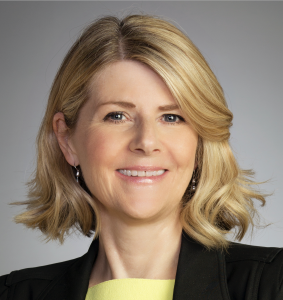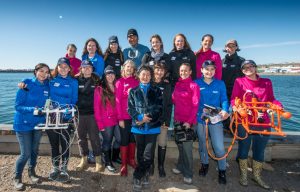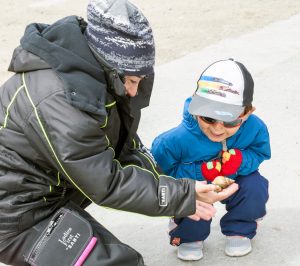Google the term ‘polar explorer’ and you’ll turn up a list of men – names such as Ernest Shackleton, James Clark Ross, Robert Falcon Scott, Fridtjof Nansen. Canadian geoscientist, journalist and polar explorer Susan R. Eaton, is challenging that paradigm.
Named in 2015 by The Royal Canadian Geographic Society as one of Canada’s greatest 100 modern-day explorers and trailblazers, Eaton has been travelling and investigating the world’s oceans all her life, initially inspired by her marine biologist mother. But her attitude to exploration changed its focus a decade ago following a scuba diving incident.

A prolific scuba diver for more than 30 years, her diving career came to an end in 2008 when she ended up in a hyperbaric chamber after a suffering an arterial gas embolism. “When I emerged from the chamber, I was no longer a diver. But, as they say, out of adversity comes opportunity,” she told The Brilliant.
A medical workup at the time revealed to Eaton that she’d been born with a patent foramen ovule – a small perforation in the septum between the venous and arterial chambers of the heart – which had allowed the compressed gases, which are breathed during scuba diving, to shunt under pressure, leading to her embolism. “After a year or so of feeling sorry for myself, I embarked on a journey, from the Antarctic to the Arctic, to explore the world’s oceans in the snorkel zones,” she explained. She calls the activity “extreme snorkelling” because the polar waters she navigates are extremely cold, dangerous, remote and full of extreme marine mammals such as belugas, narwhals and leopard seals.
This time for introspection also gave her a chance to think deeply about the nature of exploration. And, in 2014, frustrated by the male-dominated and traditional nature of scientific expeditions, she formed the female-led and operated Sedna Epic Expeditions, for polar exploration. As well as being organised for women by women, the venture also has another point of difference – Inuit women team members and cultural advisors.
There’s no point in exploring the Arctic as a group of scientists, artists and educators, if you don’t interface with the Indigenous people of the Arctic and you don’t understand the Arctic through their eyes,” she explained.
Throughout her career Eaton has been acutely aware that women are in the minority in geosciences and polar exploration and “there’s not really many safe places for women to get that field experience”. As an example of some of the issues they face, she points to the recent experience of environmental journalist Chelsea Harvey and other women reporters in 2019 when a strict dress code was implemented three weeks into the expedition aboard the science research vessel Akademik Fedorov as part of the MOSAiC Expedition, a year-long expedition to the central Arctic. “The implication seemed clear to the reporters and other women aboard the research vessel,” Eaton explains. “Women should dress modestly, or risk being harassed – or worse – by men on the ship.”
“For many, it was a reminder of the challenges women working in science still face, even as the gender gap narrows,” Harvey wrote of the experience.
And so Sedna Epic Expeditions, with its all-female crew and inclusion of Inuit team members and cultural advisors, represents a major departure from traditional arctic expeditions. Eaton’s original concept was to mount a women’s snorkel relay of the 3,000km Northwest Passage, in the Arctic Ocean, bringing global attention to disappearing sea ice in the Arctic. But, after leading four ocean science and dive and snorkel expeditions, her viewpoint of what’s “epic” and impactful in exploration has changed. “I didn’t want to lead a group of women, scientists, artists, divers and snorkelers, who were viewed as voyeurs or as conventional explorers. The concept of a snorkel relay of the Northwest Passage – of pitting woman against nature, which makes for great reality TV – involved achieving distances in record time and conquering the Northwest Passage, which is both a male and colonial paradigm,” she explains. “The more time I spent at the Arctic, the more I realized that the most important thing that Team Sedna could do, would be to work at the grassroots level in a really collaborative way with indigenous youth and girls, in particular.
By working in Indigenous communities, I wanted to acknowledge that climate change has a human face in the Arctic, and that it’s happening at an alarming rate and in real-time in Canada. The extent and the thickness of sea ice is changing rapidly in the Arctic to the extent that the Inuit are having difficulty in catching up to the new norm.”
Sedna runs an ocean knowledge sharing and mobilization program for circumpolar Indigenous peoples: since 2014, Sedna’s sea women have brought the ocean to eye level for more than 1,000 Inuit Elders, youths and girls in Greenland and Canada. The program has been delivered in collaboration with Inuit cultural advisors from Canada and Greenland who form an integral part of the Sedna team.
Sedna Epic focuses on the health, wellness and empowerment of matriarchal societies in the face of a rapidly changing environment. “We introduce young Indigenous women to ocean opportunities that most of them may not have considered. They could become a marine biologist or archaeologist, an underwater documentary maker or photographer or a scuba diving instructor,” Eaton explains. “Most of them have never imagined these potential careers, much less that they that exist in their local area. The big challenge, for Inuit youth, is that post-secondary education occurs primarily in Canada’s southern provinces, thousands of kilometres away. As such, it’s very culturally challenging for young Inuit to be so far from their small, close-knit communities”.
Eaton relates that death by drowning is a serious issue in the Arctic because learning to swim hasn’t traditionally been possible in the Canadian Arctic, where very few communities have swimming pools. “If Inuit fall through the ice or out of their boats, they can drown or die of hypothermia,” Eaton says. “Parents and grandparents warn children about monsters in the water who will pull them under if they get too close to the water’s edge. These monsters are part their Inuit legends. So, the people don’t go in the water.”
The Sedna team introduces girls and young women who have swimming skills to snorkelling, enabling them to experience the wildlife in their own waters. “The Inuit don’t see what lies below the waves in their backyard. They engage in subsistence hunting of marine mammals, but there are many other marine species that they don’t see. We also train and certify young Inuit women to become polar scuba divers.” See the video of two of these young women here.

The Sedna team has also introduced an innovative robotics program, enabling kids to explore the water around them, without entering it themselves. “We arrive in Indigenous communities with six to eight underwater robot kits comprised of PVC pipe segments and connectors, propellers, floatation and miniature video cameras. The kids design, build and fly them. And if the robots don’t float or move through the water, efficiently, the kids can pull apart the PVC pipe and redesign them,” Eaton says. “They don’t need a lot of handholding. We also run snorkel safaris for girls and young women.” These programs, which are described as “bringing the ocean to eye level”, have now been delivered to 1000 Inuit boys, girls and Elders across Greenland. The robots are donated to the remote communities for the teachers to continue to use with their students.

Sedna also supports Inuit youth by setting up touch aquariums populated with small fish and invertebrates that the scientific divers in the team collect. “The entire community comes out to see these sea critters they don’t normally see unless their carcasses wash ashore,” Eaton explains. “During our ocean knowledge sharing program, we find out from the community if there are Inuit names and legends attached to these animals. This information exchange is a lot of fun, and we generally learn more from the Inuit than they do from us.”
The ocean science undertaken by the team is extraordinarily varied and reflects the unique diversity of the team, which has included underwater robot experts, submersible pilots, maritime archaeologists, coastal anthropologists, artists, underwater documentary film-makers and photographers, university professors, high school teachers, lawyers, physicians, paramedics and journalists. “We’ve attempted to affix satellite tags on Greenland sharks, trolled for plastic in the water, taken samples of orca snot and tissues for eDNA studies and acoustically recorded the sounds of whales, pack ice and calving icebergs,” Eaton says. “We’ve deployed electronic instruments to measure density, salinity and conductivity of ocean waters, tested diver propulsion vehicles, which tow divers through the water at six kilometres per hour, and collaborated with a variety of academicians who are studying the impacts of climate change in polar regions.”
Across the four expeditions taken to date, 85 women ranging in age from 16–78 have participated. Eaton has made a point of inviting women of all decades to participate in the Sedna expeditions, ensuring women of all ages are present and have a voice in polar exploration. Sedna’s sea women are leaders in their respective fields. Yet, without exception the women tell me that the connection with remote Indigenous communities has been the most important part of the expeditions for them,” Eaton says.
Overwhelmingly participants have told her that the highlight of the expeditions has been meeting the Indigenous girls and women of the Arctic and understanding their matriarchal societies and community issues.
Eaton plans to increase the number of Indigenous women participating in the expeditions, enabling Sedna to deepen its community connections, bringing a more inclusive approach missing from many other visiting scientific teams.
The more time Eaton spends working in the Arctic, the more she realises how important it is for exploration of the region to include the local people.
You can’t really conduct science or have an amazing introspective experience if you don’t understand what you’re seeing and if you don’t understand it through the eyes of Indigenous peoples of the Arctic,” Eaton says. “Women explore the planet differently.”
Follow Sedna Expeditions on Twitter | Facebook | Instagram | Youtube | Website
Follow Susan Eaton on Twitter
Article by Kylie Ahern
Photo courtesy of SednaEpic.com – Jill Heinerth


Comments are closed.